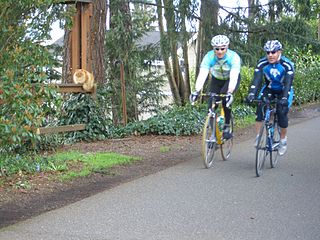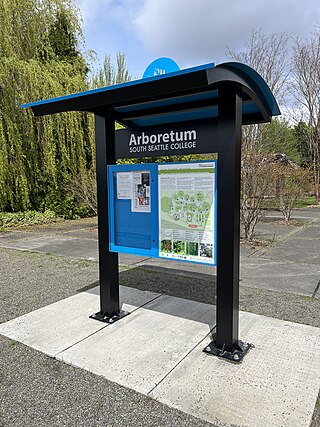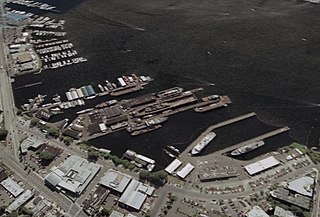
The Carl S. English Jr. Botanical Gardens (7 acres) are botanical gardens located on the grounds of the Hiram M. Chittenden Locks at 3015 NW 54th Street, Seattle, Washington.

The Carl S. English Jr. Botanical Gardens (7 acres) are botanical gardens located on the grounds of the Hiram M. Chittenden Locks at 3015 NW 54th Street, Seattle, Washington.
The gardens contain more than 500 species and 1,500 varieties of plants from around the world, including fan palms, oaks, Mexican pines, rhododendrons, and a fine display of roses. The gardens also exhibit an extensive fuchsia display and a special section for lilies in season.
After the locks were built in 1911, landscape architect Carl English of the United States Army Corps of Engineers transformed the construction site into garden in an English landscape style. [1] All told, he spent 43 years planting and tending the gardens. [2] [3]

The Lake Washington Ship Canal, which runs through the city of Seattle, connects the fresh water body of Lake Washington with the salt water inland sea of Puget Sound. The Hiram M. Chittenden Locks accommodate the approximately 20-foot (6.1 m) difference in water level between Lake Washington and the sound. The canal runs east–west and connects Union Bay, the Montlake Cut, Portage Bay, Lake Union, the Fremont Cut, Salmon Bay, and Shilshole Bay, which is part of the sound.

The Fremont Cut is a canal in Seattle, Washington, United States, that connects Lake Union to the east with Salmon Bay to the west. It is part of the Lake Washington Ship Canal linking Lake Washington to Puget Sound, and is 5,800 feet (1,800 m) long and 270 feet (82 m) wide. The center channel is 100 feet (30 m) wide and 30 feet (9.1 m) deep.

Shilshole Bay is the part of Puget Sound east of a line drawn northeasterly from Seattle's West Point in the southwest to its Golden Gardens Park in the northeast. On its shores lie Discovery Park, the Lawton Wood section of the Magnolia neighborhood, the neighborhood of Ballard, and Golden Gardens Park. It is home to the Shilshole Bay Marina on Ballard's Seaview Avenue N.W. and communicates with the Lake Washington Ship Canal via the Ballard Locks.

Salmon Bay is a portion of the Lake Washington Ship Canal, which passes through the city of Seattle, linking Lake Washington to Puget Sound, lying west of the Fremont Cut. It is the westernmost section of the canal and empties into Puget Sound's Shilshole Bay. Because of the Hiram M. Chittenden Locks, the smaller, western half of the bay is salt water, and the eastern half is fresh water. Before the construction of the Ship Canal, Salmon Bay was entirely salt water.

The Hiram M. Chittenden Locks, or Ballard Locks, is a complex of locks at the west end of Salmon Bay in Seattle, Washington's Lake Washington Ship Canal, between the neighborhoods of Ballard to the north and Magnolia to the south.

The Burke–Gilman Trail is a rail trail in King County, Washington. The 27-mile (43 km) multi-use recreational trail is part of the King County Regional Trail System and occupies an abandoned Seattle, Lake Shore and Eastern Railway (SLS&E) corridor.

The Salmon Bay Bridge, also known as Bridge No. 4, is a Strauss Heel-trunnion single-leaf bascule bridge spanning across Salmon Bay and connecting Magnolia/Interbay to Ballard in Seattle, Washington. The bridge is located just west of Commodore Park. It carries the main line of the BNSF Railway, the Scenic Subdivision, on its way north to Everett and south to King Street Station and Seattle's Industrial District.

Hiram Martin Chittenden was an American engineer and historian. A graduate of West Point, he was the Seattle district engineer for the Army Corps of Engineers from 1906 to 1908). Chittenden was one of the first three elected Port Commissioners at the Port of Seattle. He also helped found the Pacific Coast Association of Port Authorities, later known as the Association of Pacific Ports in 1913. The Hiram M. Chittenden Locks in Seattle are named in his honor.

Highline Botanical Garden is a 10.5-acre (4.2 ha) community botanical garden located at 13735 24th Avenue South, SeaTac, Washington. It is open daily without charge.

Lakewold Gardens is a 10-acre (40,000 m2) non-profit estate garden located at 12317 Gravelly Lake Drive SW, Lakewood, Washington, in an area known as the Lakes District. It is open to visitors year-round.

Bellevue Botanical Garden is a botanical garden east of downtown Bellevue, Washington on Main Street. Established in 1992, many different organizations work to maintain the garden to keep it free of charge. What began as a 7-acre gift to the city in the early 1980s has now become a 53-acre public park with multiple gardens. This includes the Fuchsia Garden, Lost Meadow Trail, Native Discovery Garden, Perennial Border, Rhododendron Glen, The Urban Meadow, Waterwise Garden, Yao Garden, and Dahlia Display.

The South Seattle College Arboretum is a 6-acre (24,000 m2) arboretum and botanical garden located at the north end of the South Seattle College campus in Seattle, Washington. It is open daily without charge. The Seattle Chinese Garden is adjacent.

W. T. Preston is a specialized sternwheeler that operated as a snagboat, removing log jams and natural debris that prevented river navigation on several Puget Sound-area rivers. She is now the centerpiece of the Snagboat Heritage Center in Anacortes, Washington. She was designated a National Historic Landmark in 1989. Built in 1929, she is one of two surviving snagboats built and operated by the United States Army Corps of Engineers, and the only one on the American west coast.

Fishermen's Terminal is a dock opened in 1914 and operated by the Port of Seattle as the home port for Seattle's commercial fishing fleet, and, since 2002, non-commercial pleasure craft. The Terminal is on Salmon Bay in the Interbay neighborhood, east of the Hiram M. Chittenden Locks and immediately west of the Ballard Bridge.

Lake Union Drydock Company is a full-service shipyard that specializes in vessel repair and conversions located in Seattle, Washington. Drydocking vessels up to 6000 tons, Lake Union Drydock Company repairs factory trawlers, fishing vessels, Coast Guard Cutters and buoy tenders, tugboats, research vessels, ferries, mega-yachts, barges, and houseboats.

The Volunteer Park Conservatory is a botanical garden, conservatory, and Seattle landmark located in Seattle, Washington at the north end of Volunteer Park on Capitol Hill.

The Ballard Avenue Historic District is a section of downtown Ballard in Seattle, Washington, that was listed on the National Register of Historic Places in 1976. The district consists of Ballard Avenue N.W. between N.W. Market Street and N.W. Dock Place, and is located near to and along Salmon Bay. After initial work by the Ballard Avenue Association and the city of Seattle's Urban Conservation Division, Seattle mayor Wes Uhlman signed the ordinances that led to the national recognition of the area. The neighborhood of Ballard is known for a large historic population and presence of immigrants from Sweden, and King Gustaf of Sweden read the proclamation inducting the district to the historical registry in 1976, and at the same time dedicated the new bell tower at Ballard's Marvin's Garden Park, which housed the original bell from Ballard's old city hall. The historic markers that can be seen on 26 of the buildings were created and erected by the Ballard Historical Society.
Founded in 1998, the History House of Greater Seattle is a historical museum dedicated to the history and heritage of Seattle and its neighborhoods.

Leschi was a steam ferry that operated on Lake Washington from 1913 to 1950, and afterwards on Puget Sound until 1967. From 1969 to 1986 the vessel was a floating cannery in Alaska.

The following outline is provided as an overview of and topical guide to infrastructure of the U.S. state of Washington.